Phonological awareness
Children will listen to and identify a sequence of two similar single sounds.


Review:

Be Prepared: Today’s listening game emphasizes the sequence of two similar single sounds, including some sounds not offered in prior versions of this game. Again, use a box with a lid to hide items used for making a sound. See Week 2, Day 2 for sound possibilities. Additional sound possibilities include:
| drumming | clearing a throat | writing on a whiteboard |
|---|---|---|
| bouncing ball | puzzle pieces in a box | marker lid clicking on a marker |
| clock ticking | toy cash register |
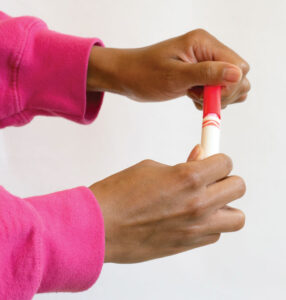 Today we will play another listening game. We will listen for two sounds just like we did last week. Remember, we pay close attention to what we are hearing when we listen.
Today we will play another listening game. We will listen for two sounds just like we did last week. Remember, we pay close attention to what we are hearing when we listen.
We will first keep our eyes open while we listen to the sounds. Then we will close our eyes and take turns guessing the sounds we hear. I will ask one person to guess the two sounds and which sound came first after we open our eyes. This way we can make sure everyone gets a turn to guess the sounds. Please do not say the name of the sounds out loud if it is not your turn.
Are you ready to use your listening ears again? Okay!
[Make two single and similar sounds with children’s eyes open. Say the name of each sound. Examples of similar sounds include:
| ringing a bell and a phone ringing | turning pages of a book and crumpling paper |
|---|---|
| drumming and bouncing a ball | hammering and knocking on a door |
| clearing a throat and coughing | snapping fingers and clapping |
Invite children to open their eyes. Then invite one child to describe the sounds (first question below) and another child to tell the order of sounds (second and third questions below).]
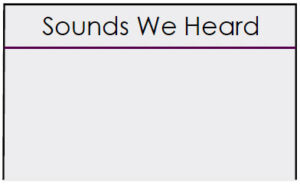 I am going to write the names of the sounds we heard on our chart just like we did last week.
I am going to write the names of the sounds we heard on our chart just like we did last week.
[Point to chart.]
The words at the top of the chart say Sounds We Heard. I will write the words _____ and _____ next to each other on our chart.
[After you write both words on the chart, point to each word and read it aloud.]
We worked hard to listen for two sounds and to remember the two sounds. Let’s listen to two more sounds.
[Introduce three sounds that sound similar. Introduce the sounds to children with eyes open and then ask children to close their eyes as you make two of the sounds again. Invite one child to guess the sounds and a different child to say which sound came first. Then review the sounds. Example: “There were two sounds. First we heard a _____, and then we heard a _____.” Write the name of both sounds next to each other on the chart. Point to both words and read them aloud. Make sure each child gets a turn.]
Today we played another listening game. We listened to two different sounds. Then we each guessed the two sounds and wrote them on a chart. Let’s look at our chart to remember all of the sounds we guessed during our listening game. Our chart says Sounds We Heard.
[Point to each word on the chart as you say it. Point to and say the name of each sound on the chart.]
Extra support
Enrichment
Invite children to draw a picture of the two sounds they guessed during the activity. Some will be easier to draw (for example, a ball) than others (clearing a throat). Example: If a child heard drumming and a bouncing ball, he/she would draw a picture of a drum and a ball. Provide sound-making items used during the activity.
Try a new game of two sounds with preschool-age children in your setting: Make two sounds and ask children to guess both sounds. Then, make only one of the sounds. Ask children to identify which sound is missing. School-age children may enjoy being “sound detectives.” Provide clipboards and pencils. Invite school-age children to explore your setting or outdoor environment and write down the sounds they hear.
Number knowledge
Children will identify groups of 2–3 items with and without counting.


Review:

Yesterday we read a book about five monkeys. Let’s hold up five fingers. We also practiced finding groups of two and three items in our classroom. Let’s look again at the book and see if we can find groups of 2–3 monkeys.
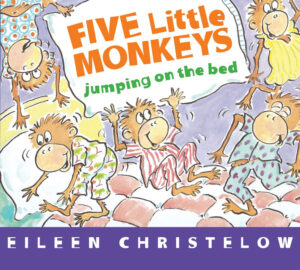 [Go through some pages in the book to find groups of 2–3. Then, go through pages in backward fashion, beginning with the page with five monkeys. With each page, ask: “Are there two or three monkeys on this page? (no, until we get to the page with two or three) Let’s keep looking.”]
[Go through some pages in the book to find groups of 2–3. Then, go through pages in backward fashion, beginning with the page with five monkeys. With each page, ask: “Are there two or three monkeys on this page? (no, until we get to the page with two or three) Let’s keep looking.”]
Today we will use circles (counters) to find groups of 1, 2, and 3.
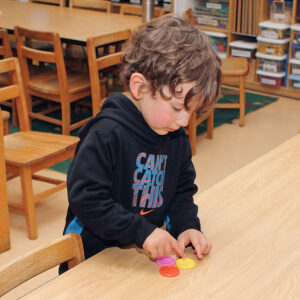
I will put a group of circles in front of me.
[Place a group of 1, 2, or 3 counters in front of you, depending on your understanding of most children’s skill in quickly identifying the number of items in a small group without counting.]
[Repeat this activity several times, using the same number of counters or up to three counters, depending on whether most children can quickly indicate how many counters are in the group.]
Now we are going to try this activity with circles that are different colors.
[Place a group of 1–3 different-colored counters in front of you. Use the same type of counter, but in different colors. Begin with a group of 1–2.]
[As children show mastery of these smaller groups, move to a group of three. Ask children to tell how many as soon as they know.]
[Put three red counters in a group. Put three counters of different colors in a second group.]
We have three red circles in a group. Is it the same as having three circles that are different colors in a group?
Each group of three is a group of three no matter what color the circles are in the group. In this activity, we pay attention to the number of circles. We do not pay attention to the color of the circles.
Today we practiced looking at groups of 1–3 items and tried to decide how many were in each group. Sometimes we can look at a small group of items and know how many without counting!
Extra support
Enrichment
Provide three plastic cups. On each cup, place 1–3 dots so that there is one cup for each amount. Invite children to place the correct group of counters into each cup. Observe children as they determine the number in each group on the cup. Do they count the dots or can children determine the size of the group by just looking?
Encourage all children in your setting to determine if groups of items have the same amount. Give preschool-age children a group of 1–3 items of the same kind (1–3 craft sticks, 1–3 blocks, etc.). Give them another group of items of the same amount as the first group but with items of different kinds (different kinds of stuffed animals, different kinds of play food). Ask children if both groups are equal. School-age children will enjoy matching a group of items with the same number of items in a second group. Example: Child places six different types of cars on a table and then makes another group of six different items.
Self-control
Children will understand why it is important to raise our hand in a group if we would like to speak.

None

New:

Yesterday we learned about why it is important to listen. Who can tell us one reason it is important to listen in the classroom? (to learn things, to know what to do)
Today we will learn an important way to talk in a group. Sometimes we all have ideas we want to share. If we share them all at the same time, we will not be able to hear what each person says. Let me show you.
I will ask you a question. I want everyone to answer at the same time as soon as I ask it. Ready, here we go.
What is your favorite animal?
[Encourage children to answer at the same time. If necessary, ask another question so children can understand that when they all talk at the same time, their answer cannot be heard.]
When we all answered at the same time, it was noisy! We couldn’t hear many of our answers.
We are going to learn a way for everyone to talk and be heard. It’s called raising your hand.
[Demonstrate raising your hand.]
When we raise our hand, it lets us know you have something to say. The trick is to raise your hand quietly. We don’t talk when we raise our hand quietly.
[Demonstrate raising your hand and putting your pointing finger over your mouth.]
When we raise our hands, we raise our hands gently, straight up in the air towards the sky. We don’t swing our arms or wave them side to side because this might hurt the people sitting next to us.
[Demonstrate raising your hand gently by slowly putting hand straight up in the air.]
I will ask another question. Please raise your hand quietly if you would like to answer the question. Let’s try it.
[Have another adult sit among the children. Ask a question such as “What is your favorite color?” Have the adult among the children model how to raise his/her hand while sitting quietly.]
I asked a question and now I am looking at children who are sitting quietly and raising their hand. See how _____ is sitting quietly and raising his/her hand? Now I am going to call his/her name so he/she can answer the question.
[Call on the adult who is modeling raising his/her hand. After the adult has answered the question, ask if someone else would like to answer the question.]
I am looking for quiet sitters with their hand up.
[Praise children who are waiting quietly but only call on one child at a time, praising the other children in between turns. Call on children who are sitting quietly with their hand up. Example: “I am calling on Diane because she has her hand up and is waiting patiently.” Young children may need an alternative to raising their hand as they gain an understanding of this expectation. Tapping an adult on the arm or shoulder may be easier for young children to understand and implement. Give several reminders that you are looking for a “quiet sitter with hand up” if necessary. Be sure to call on every child who is sitting quietly and raising his/her hand.]
We are being patient when we quietly sit with our hand up. When we are patient, we wait our turn without getting upset and without complaining. Sometimes it can be hard to be patient.
Sometimes it is hard to raise our hand and wait until it is our turn to talk. But, when we are patient and raise our hand, everyone gets a chance to speak and be heard.
Who can think of something to do while we are patiently waiting our turn to speak? (listen to the speaker, think about what you want to say)
Let’s practice raising our hands again. This time I want you to think of a question you would like to ask me. It can be about my favorite sport, or maybe what I had for breakfast. If you think of a question, raise your hand and I will call on you one at a time to tell me your question.
[Remind children that you are looking for “quiet sitters with their hand up” as you call on children. Be sure to verbally recognize by name each child who is showing appropriate behavior.]
Today we learned that we need to raise our hand when we want to speak in a group. Why should we raise our hand? (so people can hear us, so everyone can have a turn to speak and be heard)
[Continue to practice this new skill. Remain consistent as you call only on “quiet sitters” with their hand raised. Continued reminders and consistency will help children understand what is expected of them.]
Extra support
Enrichment
Children will enjoy practicing their listening skills while playing a “do as I do” game. Invite one child to be the leader of the game. Encourage the child to raise his/her hand as he/she states what the other children should do. Example: “Clap your hands just like me!” Raising his/her hand will reinforce that he/she has something to say. Encourage children to take turns leading the game.
Invite children to practice their listening skills by playing a game such as Simon Says. Children will need to listen carefully to the speaker to know what to do in the game. Invite school-age children to be “Simon” as preschool-age children listen carefully for what to do. Encourage “Simon” to raise his/her hand each time he/she says something. This will reinforce that he/she has something to say.
Inquiry skills
Children will understand how to learn about something by trying to change it.


New:
Review:


Yesterday we answered the question, “What are ice cubes like?” We were scientists with our ice cubes.
[Display Day 1 chart.]
Let’s look again at our chart about ice cubes. Our chart helps us remember what we learned about ice cubes. I am going to read how we described our ice cubes.
[Point to and read each word on the chart.]
Today we will do something different with our ice cubes.
Have you ever observed what happens when water is poured on an ice cube?
[Encourage children to describe what they know about putting water on an ice cube.]
We are going to observe what happens when we pour water on some ice cubes.
Each of us will get two bowls of ice. I will pour water in only one bowl.
[Give each child two bowls with several ice cubes in each bowl. Carefully pour water over the ice cubes in one bowl.]
Ice cubes are made of frozen water. When something is frozen, it turns to ice because it is very cold. Ice cubes change by melting when they get warm. When ice melts it turns back into water.
We are comparing what happens to our ice cubes when they have water poured on them and when they do not have water poured on them. When we compare things, we look for ways they are the same or different.
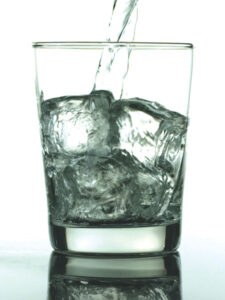 How did our ice cubes change when we poured water on them? (melted, got smaller, turned into water)
How did our ice cubes change when we poured water on them? (melted, got smaller, turned into water)Today we learned about ice by trying to change our ice cubes.
Today we learned something about ice by trying to change ice cubes. We poured water into one bowl of ice cubes and did not pour water on another bowl of ice cubes. We observed and described what happened to our two bowls of ice cubes. We compared our ice cubes in water to our ice cubes not in water. Are we doing what scientists do? (yes!)
Extra support
Enrichment
Fill the water table or a tub with a small amount of water. Periodically, put ice cubes into the water and encourage children to play with them and watch them melt. Provide cups, spoons, and other materials for exploration. If the water gets too cold for children, add some warmer water as they play.
Invite children to observe other things that are cold and frozen. Take a look in a freezer, if available, and ask children to feel how cold other things are when they are frozen. Do the items feel as cold as ice cubes? School-age children may enjoy the challenge of comparing frozen items to items in the refrigerator. Point out that frozen and refrigerated items are both cold but they are different. How are they different? Ask children how we can make refrigerated items as cold as frozen items.